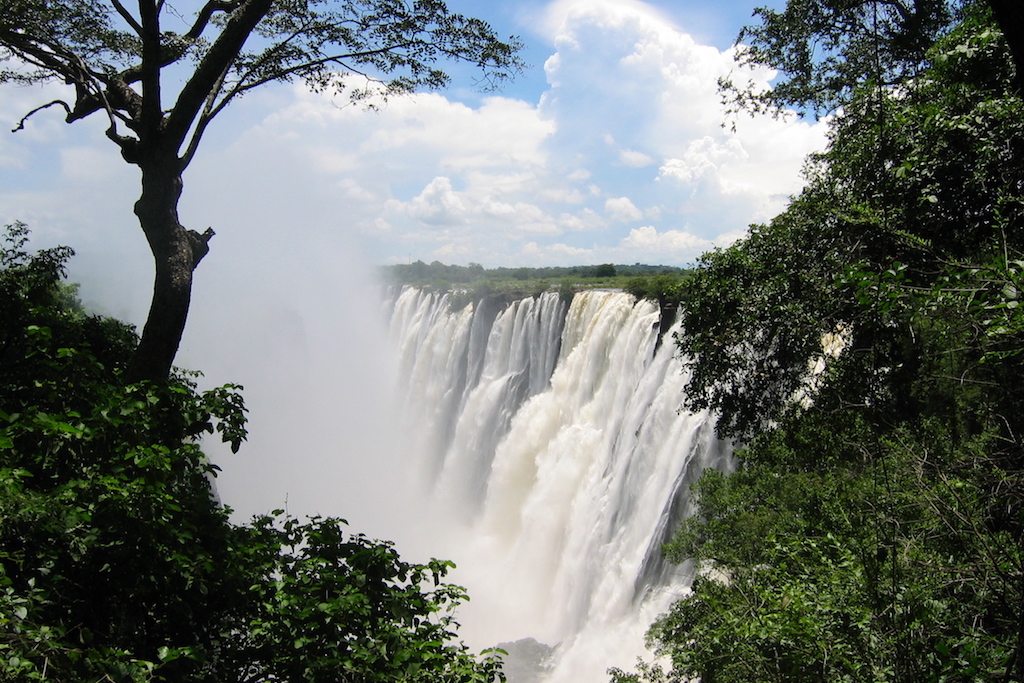Skift Take
For tourism operators surrounding Victoria Falls, the fabled Zambezi river god Nyami Nyami appears to be smiling on them at last. After years in the tourism wilderness, the tide has turned and business is booming in the northern reaches of Zimbabwe.
 Editor’s Note: Skift launched a new series, Gateway, to broaden our news coverage geographically with first-hand, original stories from correspondents embedded in cities around the world.
Editor’s Note: Skift launched a new series, Gateway, to broaden our news coverage geographically with first-hand, original stories from correspondents embedded in cities around the world.
We are featuring regular reports from Beijing, Singapore and Cape Town. Gateway Cape Town, for example, signifies that the reporter is writing from that city although his coverage of the business of travel will meander to other locales in the region. Read about the series here, and check out all the stories in the series here.
“Scenes so lovely must have been gazed upon by angels in their flight,” wrote missionary and explorer David Livingstone in 1855, after “discovering” the Victoria Falls and naming them for his dowager Queen.
It’s hard not to be impressed by Mosi-oa-Tunya — “the smoke that thunders” — as the Zambezi River tumbles down into the Batoka Gorge in a 1.7 kilometer-wide curtain of water. It is, undoubtedly, one of the great natural wonders of the world.
But even the force of the Falls isn’t immune to politics and nervous tourists. For years arrivals have faltered, a victim of Zimbabwe’s disastrous economic and political policies.
That situation is changing though. Relative political stability in Zimbabwe has eased safety fears, and the 2009 “dollarization” of the country “put an end to hyperinflation and stabilised the economy.
In the early 2000s, before the tourism and economic crash in Zimbabwe, there was a Go To Vic Falls promotional entity, but it folded several years ago. These days it’s mostly private companies and brands that promote visitation.
Since then business has improved year on year, particularly in the Victoria Falls region, says Chris Roche, chief marketing officer at Wilderness Safaris. “Over the last three years Zimbabwe tourism arrivals have grown steadily and outstrip those of neighbouring Zambia.”
“While the economic outlook on the country is still difficult, and it of course does still have its issues, the country is far more stable than it was before,” says Joss Kent, chief executive officer of safari operator &Beyond. “The world is seeing it as a safer place to travel to again, and it does boast some of the continent’s iconic destinations.”
Another key ingredient in the growing arrival numbers is the reintroduction in December 2016 of the Kavango-Zambezi (KAZA) uni-visa. The visa allows citizens of 40 countries — including the key U.S. and European markets — to transit easily between Zimbabwe and Zambia, and stay for up to 30 days in both countries.
Capacity Grows
While reliable arrival figures are hard to come by, an excellent bellwether — and enabler — of the rising demand for the destination is the availability and growth in air access. On that metric, Victoria Falls appears the hottest ticket in Africa for 2017 because within three months, three major pan-African carriers have significantly increased capacity to the destination.
Actually, for Zimbabwe, the World Travel and Tourism Council forecasts a slight uptick in international tourism arrivals to 2.1 million in 2017.
Since March, South African Airways has deployed a 222-seat Airbus A330-200 on its daily flights from Johannesburg to Victoria Falls, a 30 percent increase in capacity.
Ethiopian Airlines is also taking a slice of the action, launching four flights per week from its hub in Addis Ababa using a Boeing 737. From May Kenya Airways will begin direct flights three times a week from Nairobi to Victoria Falls, continuing on to Cape Town, South Africa. These flights, operated by Embraer E190s with a 12-84 business-economy split, are in addition to its existing service linking Nairobi, Livingstone (on the Zambian side of the Falls) and Cape Town. Both routes have fifth freedom rights, allowing passengers to embark and disembark at each stop.
The slew of new airlines is largely thanks to the $150 million renovation of the Victoria Falls International Airport, which included a new international terminal and 4,000-metre runway capable of handling wide-body long-haul aircraft.
The improved “airport infrastructure, including runway strength, together with other key elements such as operating times and seamless connectivity intra-Africa were the deciding factor for the route,” says Helena Maxwell, area manager southern Africa, Angola and Indian Ocean Islands for Kenya Airways.
“These three airlines alone add 80 000 new seats per annum into Victoria Falls International Airport and the region, offering a huge opportunity for growth, as well as connecting new destinations with the incredible Victoria Falls hub and KAZA tourism region,” said Ross Kennedy, chief executive officer of Africa Albida Tourism (AAT), in a recent press statement. AAT is a Zimbabwe-owned hospitality group that operates four lodges in and around Victoria Falls.
Regional carrier Airlink is also throwing its hat in the ring, launching six flights per week from Cape Town to Victoria Falls from July.
The route “has been on Airlink’s radar for considerable time,” said chief executive officer Rodger Foster. “Forward sales have far exceeded expectations. This is a clear indication that the service is highly demanded and long overdue.”
Victoria Falls is also seeing a surge in investment on the ground.
The Zimbabwe National Roads Administration has allocated more than $200,000 for road improvements in Victoria Falls town, including the iconic bridge across the Batoka Gorge to Zambia, while lodges in and around town are upgrading to meet demand.
Victoria Falls River Lodge in Zimbabwe will launch an exclusive Island Lodge in August, offering three tree house suites situated on a private Zambezi River island, while Ilala Lodge, overlooking the Falls, is revamping accommodation and communal areas.
Local tour operator Shearwater Adventures recently invested US$1.2-million in a new 150-bed campsite and chalet facility dubbed Explorers Village, with further accommodation in development.
Perhaps the most impressive new investment is the reopening of &Beyond Matetsi River Lodge in 2016. After being shuttered in 2012, a $10 million investment into the property has transformed it into one of the most talked about safari lodges in the region.
The knock-on effect for the region is also worth noting, with an increasing number of tourists to Victoria Falls often extending to other safari lodges in the region.
“Allied to the growth in arrivals to the Falls themselves is an increased demand for longer itineraries in the safari areas of northern Zimbabwe, such as Hwange and Mana Pools National Parks,” adds Roche from Wilderness Safaris, which in 2015 rebuilt Linkwasha, its flagship camp in Hwange National Park, followed by further rebuilds and renovations of lodges in Mana Pools National Park in 2016.
The Daily Newsletter
Our daily coverage of the global travel industry. Written by editors and analysts from across Skift’s brands.
Have a confidential tip for Skift? Get in touch
Tags: airlines, gateway, hotels, zimbabwe
Photo credit: Relative stability in Zimbabwe has triggered an uptick in tourism and Victoria Falls area is one of the beneficiaries. Richard Holmes
